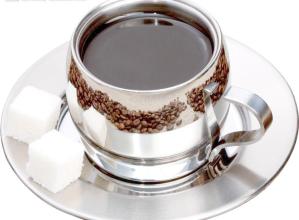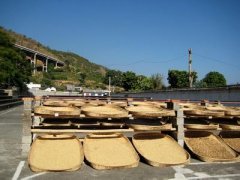Medium-sized Vietnamese coffee beans Flavor Taste Aroma Description Introduction

Vietnam's geographical location is very favorable for coffee cultivation. Southern Vietnam has a hot and humid tropical climate, which is suitable for growing ROBUSTA coffee, while the north is suitable for growing ARABICA coffee. Coffee production in Vietnam has the following characteristics: (1) because there is no effective way to deal with fallen leaves, medium-grain coffee was selected as the main variety in the early 1980s. (2) based on the planting technology, the coffee planting method was determined, that is, under the hot and humid climate in southern Vietnam, high density planting, large amount of irrigation, excessive fertilization and no shading trees were used to obtain the maximum yield and give full play to the production capacity of medium-grain coffee. The per unit yield of many coffee plantations in Daklak, GiaLai, Kontum and DongNai areas of Vietnam reached 340t / ha. The yield of some plantations is even as high as 89.9 tons per hectare. (3) processing technology: mainly making full use of the solar energy drying method in the dry season in the plateau of central Vietnam to process coffee.
Vietnamese coffee, also known as Didi Jin, has to be ordered 10 minutes in advance. Since French missionaries brought coffee to Vietnam 150 years ago, Vietnam has gradually developed its own unique coffee culture.
The style of coffee in Vietnam lies largely in its brewing process. It is not brewed in a coffee pot, but a special drip-filter coffee pot, followed by an old-fashioned printed glass, just like an hourglass in time. Every drop is used to pass the time. When you do it, put the coffee powder on the drip pot on the cup holder below, press a piece of metal with holes, and then brew it with hot water to let the coffee drip into the cup. When making hot coffee, keep the cup warm in a large bowl filled with boiling water, because it may take three to ten minutes to drip a cup of coffee, and the hot coffee will cool off. Some people like to add a layer of sweet condensed milk under the cup, wait for the coffee to drop into the cup, and then mix the coffee with white condensed milk to drink. If it is black coffee, generally do not give you straws, if there is condensed milk will give you straws. Only those who can bear the patience will wait until a cup of coffee has been dripped, then drink it slowly and appreciate the beauty of slow life.
The following is a description of the production method
Prepare materials:
1. Small mouth pot (the mouth is as thin as possible, it is easy to inject water)
2. Condensed milk
3. Coffee powder
4. Dripping pot
5. Coffee cup (it must be transparent to be authentic, otherwise it will be no fun if you can't see the process)
Production:
1. Add proper condensed milk to the cup and add condensed milk is the characteristic of Vietnamese coffee.
2. Fill the Didi pot with coffee powder and shake it flat.
3. Screw on the pressing plate to press the coffee powder properly. The screws of the pressing plate should be loosened and tightened properly, and it is appropriate to drip in about three minutes.
4. Put the drip pot on the cup, and then pour some water to soak the coffee powder but not drip it. This step is also used in follicular coffee, the technical term "stew".
5. After 20 seconds or so, put about 90 degrees of water, fill it up and cover it.
6. Wait for the coffee to fill the cup slowly.
Don't stir it in a hurry when drinking it. You can taste the acidity of black coffee first, then mix it with condensed milk and add it in summer.
Almost all of the world's robusta coffee beans (Robustabean), which are often used to make instant coffee and high-end coffee blends, are exported from Vietnam. Vietnam is the world's second largest exporter of coffee, surpassing Colombia and second only to Brazil. Vietnam has a long history of coffee production, but the development and expansion of its production scale began in the last 20 years. After the ups and downs of the world coffee market from 2001 to 2005, Vietnam's coffee industry gained momentum and handed in a satisfactory answer for the world in 2005: Vietnam produced 810000 tons of coffee (13.5 million bags, 60 kg each) from 2001 to 2006. The export volume reached 776 tons (12.9 million bags), and the export value increased by 35%.
Important Notice :
前街咖啡 FrontStreet Coffee has moved to new addredd:
FrontStreet Coffee Address: 315,Donghua East Road,GuangZhou
Tel:020 38364473
- Prev

A brief introduction to the treatment method of grinding degree and baking degree of Yunnan boutique coffee beans
Due to the lack of deep processing and marketing, Yunnan coffee is not well-known and unrecognized by people locked in the mountains. It is believed that with the in-depth development of Yunnan coffee industry, the rising demand of domestic coffee market and the efforts of the government and enterprises, Yunnan coffee will usher in a new period of development. The western and southern parts of Yunnan Province are located between latitude 15 and Tropic of Cancer, with most areas above sea level.
- Next

A brief introduction to the History and Culture of the Origin and Development of Vietnamese Fine Coffee beans
At present, the development plan of coffee industry in Vietnam is adjusting its strategic direction according to the following main contents: 1. Change the planting structure and determine the strategic goal of industry development. Reduce the planting area of ROBUSTA coffee and turn the land with low efficiency in coffee cultivation into other perennial cash crops such as rubber, pepper, fruit trees and annual crops such as cotton and hybrid corn. In conditional land
Related
- Detailed explanation of Jadeite planting Land in Panamanian Jadeite Manor introduction to the grading system of Jadeite competitive bidding, Red bid, Green bid and Rose Summer
- Story of Coffee planting in Brenka region of Costa Rica Stonehenge Manor anaerobic heavy honey treatment of flavor mouth
- What's on the barrel of Blue Mountain Coffee beans?
- Can American coffee also pull flowers? How to use hot American style to pull out a good-looking pattern?
- Can you make a cold extract with coffee beans? What is the right proportion for cold-extracted coffee formula?
- Indonesian PWN Gold Mandrine Coffee Origin Features Flavor How to Chong? Mandolin coffee is American.
- A brief introduction to the flavor characteristics of Brazilian yellow bourbon coffee beans
- What is the effect of different water quality on the flavor of cold-extracted coffee? What kind of water is best for brewing coffee?
- Why do you think of Rose Summer whenever you mention Panamanian coffee?
- Introduction to the characteristics of authentic blue mountain coffee bean producing areas? What is the CIB Coffee Authority in Jamaica?

